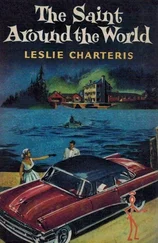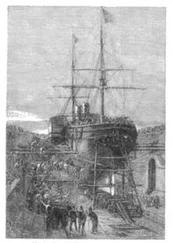Just as it was about to snap up the poor fisherman, the man-eater saw its new adversary, repositioned itself on its belly, and headed swiftly toward him.
I can see Captain Nemo’s bearing to this day. Bracing himself, he waited for the fearsome man-eater with wonderful composure, and when the latter rushed at him, the captain leaped aside with prodigious quickness, avoided a collision, and sank his dagger into its belly. But that wasn’t the end of the story. A dreadful battle was joined.
The shark bellowed, so to speak. Blood was pouring into the waves from its wounds. The sea was dyed red, and through this opaque liquid I could see nothing else.
Nothing else until the moment when, through a rift in the clouds, I saw the daring captain clinging to one of the animal’s fins, fighting the monster at close quarters, belaboring his enemy’s belly with stabs of the dagger yet unable to deliver the deciding thrust, in other words, a direct hit to the heart. In its struggles the man-eater churned the watery mass so furiously, its eddies threatened to knock me over.
I wanted to run to the captain’s rescue. But I was transfixed with horror, unable to move.
I stared, wild-eyed. I saw the fight enter a new phase. The captain fell to the seafloor, toppled by the enormous mass weighing him down. Then the shark’s jaws opened astoundingly wide, like a pair of industrial shears, and that would have been the finish of Captain Nemo had not Ned Land, quick as thought, rushed forward with his harpoon and driven its dreadful point into the shark’s underside.
The waves were saturated with masses of blood. The waters shook with the movements of the man-eater, which thrashed about with indescribable fury. Ned Land hadn’t missed his target. This was the monster’s death rattle. Pierced to the heart, it was struggling with dreadful spasms whose aftershocks knocked Conseil off his feet.
Meanwhile Ned Land pulled the captain clear. Uninjured, the latter stood up, went right to the Indian, quickly cut the rope binding the man to his stone, took the fellow in his arms, and with a vigorous kick of the heel, rose to the surface of the sea.
The three of us followed him, and a few moments later, miraculously safe, we reached the fisherman’s longboat.
Captain Nemo’s first concern was to revive this unfortunate man. I wasn’t sure he would succeed. I hoped so, since the poor devil hadn’t been under very long. But that stroke from the shark’s tail could have been his deathblow.
Fortunately, after vigorous massaging by Conseil and the captain, I saw the nearly drowned man regain consciousness little by little. He opened his eyes. How startled he must have felt, how frightened even, at seeing four huge, copper craniums leaning over him!
And above all, what must he have thought when Captain Nemo pulled a bag of pearls from a pocket in his diving suit and placed it in the fisherman’s hands? This magnificent benefaction from the Man of the Waters to the poor Indian from Ceylon was accepted by the latter with trembling hands. His bewildered eyes indicated that he didn’t know to what superhuman creatures he owed both his life and his fortune.
At the captain’s signal we returned to the bank of shellfish, and retracing our steps, we walked for half an hour until we encountered the anchor connecting the seafloor with the Nautilus’s skiff.
Back on board, the sailors helped divest us of our heavy copper carapaces.
Captain Nemo’s first words were spoken to the Canadian.
“Thank you, Mr. Land,” he told him.
“Tit for tat, captain,” Ned Land replied. “I owed it to you.”
The ghost of a smile glided across the captain’s lips, and that was all.
“To the Nautilus,” he said.
The longboat flew over the waves. A few minutes later we encountered the shark’s corpse again, floating.
From the black markings on the tips of its fins, I recognized the dreadful Squalus melanopterus from the seas of the East Indies, a variety in the species of sharks proper. It was more than twenty-five feet long; its enormous mouth occupied a third of its body. It was an adult, as could be seen from the six rows of teeth forming an isosceles triangle in its upper jaw.
Conseil looked at it with purely scientific fascination, and I’m sure he placed it, not without good reason, in the class of cartilaginous fish, order Chondropterygia with fixed gills, family Selacia, genus Squalus.
While I was contemplating this inert mass, suddenly a dozen of these voracious melanoptera appeared around our longboat; but, paying no attention to us, they pounced on the corpse and quarreled over every scrap of it.
By 8:30 we were back on board the Nautilus.
There I fell to thinking about the incidents that marked our excursion over the Mannar oysterbank. Two impressions inevitably stood out. One concerned Captain Nemo’s matchless bravery, the other his devotion to a human being, a representative of that race from which he had fled beneath the seas. In spite of everything, this strange man hadn’t yet succeeded in completely stifling his heart.
When I shared these impressions with him, he answered me in a tone touched with emotion:
“That Indian, professor, lives in the land of the oppressed, and I am to this day, and will be until my last breath, a native of that same land!”
Table of Contents
DURING THE DAY of January 29, the island of Ceylon disappeared below the horizon, and at a speed of twenty miles per hour, the Nautilus glided into the labyrinthine channels that separate the Maldive and Laccadive Islands. It likewise hugged Kiltan Island, a shore of madreporic origin discovered by Vasco da Gama in 1499 and one of nineteen chief islands in the island group of the Laccadives, located between latitude 10 degrees and 14 degrees 30’ north, and between longitude 50 degrees 72’ and 69 degrees east.
By then we had fared 16,220 miles, or 7,500 leagues, from our starting point in the seas of Japan.
The next day, January 30, when the Nautilus rose to the surface of the ocean, there was no more land in sight. Setting its course to the north-northwest, the ship headed toward the Gulf of Oman, carved out between Arabia and the Indian peninsula and providing access to the Persian Gulf.
This was obviously a blind alley with no possible outlet. So where was Captain Nemo taking us? I was unable to say. Which didn’t satisfy the Canadian, who that day asked me where we were going.
“We’re going, Mr. Ned, where the captain’s fancy takes us.”
“His fancy,” the Canadian replied, “won’t take us very far. The Persian Gulf has no outlet, and if we enter those waters, it won’t be long before we return in our tracks.”
“All right, we’ll return, Mr. Land, and after the Persian Gulf, if the Nautilus wants to visit the Red Sea, the Strait of Bab el Mandeb is still there to let us in!”
“I don’t have to tell you, sir,” Ned Land replied, “that the Red Sea is just as landlocked as the gulf, since the Isthmus of Suez hasn’t been cut all the way through yet; and even if it was, a boat as secretive as ours wouldn’t risk a canal intersected with locks. So the Red Sea won’t be our way back to Europe either.”
“But I didn’t say we’d return to Europe.”
“What do you figure, then?”
“I figure that after visiting these unusual waterways of Arabia and Egypt, the Nautilus will go back down to the Indian Ocean, perhaps through Mozambique Channel, perhaps off the Mascarene Islands, and then make for the Cape of Good Hope.”
“And once we’re at the Cape of Good Hope?” the Canadian asked with typical persistence.
“Well then, we’ll enter that Atlantic Ocean with which we aren’t yet familiar. What’s wrong, Ned my friend? Are you tired of this voyage under the seas? Are you bored with the constantly changing sight of these underwater wonders? Speaking for myself, I’ll be extremely distressed to see the end of a voyage so few men will ever have a chance to make.”
Читать дальше












